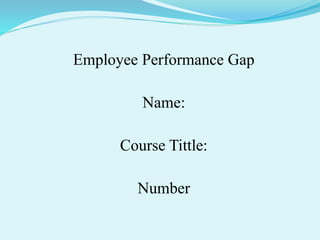
perfomance gap
- 1. Employee Performance Gap Name: Course Tittle: Number
- 2. Employee underperformance Employee work performance is one of the critical issues in any organization. Employees working with the best practices and motivation perform at their best. These employee have the knowledge that underperformance may result to unproductive outcomes that may cumulatively affect the entire workplace. It is therefore important for the organization to establish effective performance management systems that will benefit it both in the short run and long run (Lawler., et al., 1995).
- 3. Employee underperformance (cont’) The system should of course ensure that it leads to happier, motivated, and better performing employees (Ramesh & Vasuki. 2013). Underperformance can be exhibited through: Non-compliance with organization’s policies, rules, ad regulations Disruptive behavior that impacts on co-workers Unsatisfactory work performance.
- 4. Causes of performance gap Under performance may result from diverse causes either organizational, personally, or environmental. Employees do not know the expectations of the organization since its goals and standards are unclear to them. Interpersonal differences. Mismatch between employee’s job and his or her capabilities. Lack of knowledge and skills certain organization’s tasks
- 5. Causes of performance gap Lack of counseling or feedback on employee performance Lack of personal motivation, low morale or poor work environment Personal issues such as physical or mental health problems, family stress, and problems with drugs and alcohol Cultural misunderstandings Workplace bullying
- 6. Goals of a Short-term performance management plan The organization will ensure that employees: Clearly understand the organization’s goals to aid mitigating the problem with organization’s goals and standards misunderstandings. Well versed with organization’s outlined rules and regulations Provided with Improved internal communication mechanisms Recognize their contribution to the organization’s overall goal.
- 7. Permanent change components for a performance management plan Training Developing individual and organizational performance work plan Outlining the performance rating scale Conducting an interim review
- 8. Goals of a long-term performance management plan The long-term goal will ensure that: Employees are instructed as to the job expectations Employees are assigned duties and responsibilities. Improved efficiency and productivity Improved labour relations and human resource development. There is provision of training opportunities. Improved organizational structure
- 9. Trigger points for a performance management plan Trigger points help in determining what the organization should do to better the situation. Revenue misses the goal by 5% two months in a row. Technological changes. Competitor making a significant change to its products Organization’s output forecast being significantly below the plan
- 10. Coaching for employee performance Coaching is the process of empowering others (Whitemore, 2002). Helps in unlocking people’s potential to maximize their performance. It helps employees to gain commitment to action
- 11. Benefits of coaching Employee retention Enhanced employer employee communication Enhances financial performance Coaching may also help in development of executives
- 13. Coaching activities The coach explains the impacts of change and the requirements for change. Identifies what is working well and the challenges The coach reflect on the options for change and decides on the desirable solution. The coach commits to improving employee relations, skills, and performance.
- 14. References Whitmore, J. (2002). Coaching for performance: Growing People, Performance and Purpose. London: National Book Network. Lawler, E. E., Mohrman, S. A., & Ledford, G. E. (1995). Creating high performance organizations: Practices and results of employee involvement and total quality management in Fortune 1000 companies. San Francisco, CA: Jossey-Bass. Ramesh, G., & Vasuki, K. (2013). Addressing Employee's Underperformance by Nurturing a Positive Work environment. Journal of Commerce and Management Thought, 4(1), 55-69.
Hinweis der Redaktion
- An organization can achieve its short-term and long-term goals and missions through the efforts of employees.
- Underperformance of the employees is one of the common causes of organization’s failure and the need to change the situation is a primary goal for such an organization. It may be shown by employee behaviors, organization’s output, or any other factor that affects the outcomes of the overall organization’s goals and objectives.
- It is very important for an organization to understand these causes and develop a system that will ensure that they are addressed in a positive manner. Employee dissatisfaction may lead to massive underperformance due to laxity and lack of concern for the future of the organization.
- Counseling is one of the most important aspects of organization’s prosperity as it ensures that employees are appreciated and heard. The culture of the organization and that of individuals may conflict. There is need for the organization to restructure to meet the needs of the employees needs.
- An organization facing employee underperformance has always the need to set goals to achieve the required changes in the employee perfomance ituation within the shortest time possible. Since the goals of the organization cannot be abandoned and leave it at poor performance, there is need to establish new and immediate intervention mechanism for the challenge.
- The performance rating scale is composed of five levels defined as outstanding, very good, good, below average, and unsatisfactory. Training should be done either once for a given job description to ensure that employees have ability for the job. It should change with change in positions.
- They define the weaknesses or possibilities that an organization can adopt to make reduce performance gap. These triggers may stem from the existing organizations problems or the coming organizations issues like competition, technology and employee empowerement
